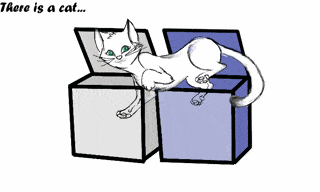It’s one of the most confusing thought experiment, but also one of the most famous in popular culture: the paradoxical state in which a cat inside a box is both alive and dead until you peer inside. Physicists at Yale University spiced things up and added a new dimension to Schrödinger’s cat by adding another box. Now, the cat is both dead and alive and sits in two boxes — all at the same time. Here goes nothing.

[panel style=”panel-info” title=”What’s the deal with Schrödinger’s cat” footer=””]In 1935, in an attempt to mock the Copenhagen interpretation of quantum mechanics (hah, who got the last laugh?), Erwin Schrödinger proposed a thought experiment: a cat is placed in a sealed box along with a radioactive sample, a Geiger counter and a bottle of poison.
If the Geiger counter detects that the radioactive material has decayed, it will trigger the smashing of the bottle of poison and the cat will be killed. Effectively, the cat’s life depends on the quantum mechanically determined state of a radioactively decaying atom.
The ‘Copenhagen interpretation’ of quantum mechanics states that a particle exists in all states at once until observed. Conversely, the radioactive material can have simultaneously decayed and not decayed in the sealed environment. In follows, that Schrödinger’s cat is both alive and dead until you open the box. Of course, everyone thought this was absurd, but it’s the absurdity he was trying to convey in the first place about the Copenhagen interpretation in practical, everyday life.[/panel]
The radioactive atom and kitty are intimately “entangled” with each other. But once an observer opens the box, the “superposition” of the cat—the idea that it was in both states—would collapse into either the knowledge that “the cat is alive” or “the cat is dead,” but not both.
So, how did Yale University added another box? They paired Schrödinger’s cat with Einstein’s “spooky action at a distance” — quantum entanglement. When two particles are entangled, a change in the state of one particle is immediately reflected in the paired particle, and when I mean immediately I literally mean now. This phenomenon isn’t some weird, purely theoretical physical caveat that exists solely in the minds of awkward physicists. It’s quite practical, even. Using the power of entanglement scientists at the National Institute of Standards and Technology (NIST) instantly transferred information from on proton to another one 100 kilometers away in 2015. Physicists call this “quantum teleportation”.

Back to the double-Schrödinger’s cat, the Yale team led by Chen Wang devised a chamber with two small aluminum cavities fitted inside. Photons were fired that bounced in and out these cavities and a superconducting chip made of sapphire connected them through a standing wave of light. Then, in each cavity a special electronic function was induced which superimposes a standing wave of two separate wavelengths of light in each cavity. In other words, the group of photons in each cavity (the cat) oscillated at two different wave lengths at once. Because the two chambers were linked by spooky action at a distance, finding out if the cat is alive or dead required opening two boxes.
“This cat is big and smart. It doesn’t stay in one box because the quantum state is shared between the two cavities and cannot be described separately,” said Wang, a postdoctoral associate at Yale and first author of a study. “One can also take an alternative view, where we have two small and simple Schrodinger’s cats, one in each box, that are entangled.”
This is the first time anyone has proven this to work, and the findings published in the journal Science could be extremely important for quantum computers.
Where traditional computers perform their calculations in binary – using 1s and 0s – quantum computers exploit the odd characteristics of the quantum state of particles at the atomic scale. Like Schrödinger’s cat, the value of a qubit isn’t definitely 1 nor 0, but both at the same time. A quantum computer is theoretically thousands of times faster than a traditional computer.
To “solve” a calculation, the quantum state is ended, so that the qubits take a classic 1 or 0 value. Setting the quantum states and superposition up correctly should mean a quantum computer will reach the same answer as a normal one. This superposition states of particles are very fragile. Once the state is lost to “decoherence”, the data becomes corrupted and unsuable. Wang says encoding redundancy in the size of the cavity itself rather than in separate, calculated bits could help solve this problem.
“It turns out ‘cat’ states are a very effective approach to storing quantum information redundantly, for implementation of quantum error correction. Generating a cat in two boxes is the first step towards logical operation between two quantum bits in an error-correctible manner,” said co-author Robert Schoelkopf, Sterling Professor of Applied Physics and Physics, and director of the Yale Quantum Institute.



